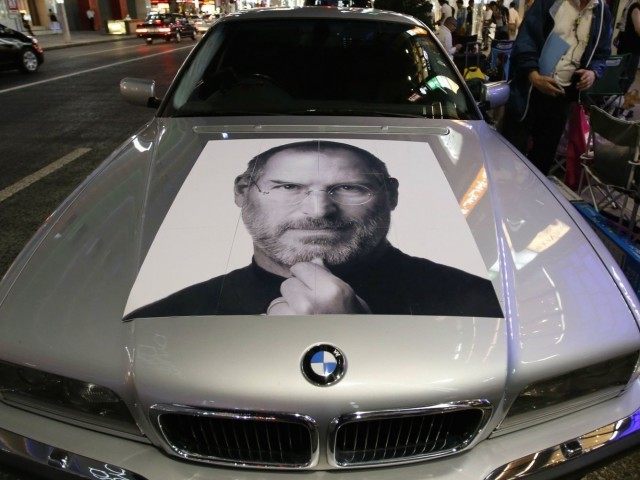Despite all the mainstream media naysayers “dissing” Apple, Inc. (NASDAQ: AAPL) for designing and building a car, I believe the economics are overwhelmingly favorable for Apple to extend its brand to vehicles.
The car of the future will require expertise in software integration, an iconic user interface and advanced battery technology. Those are exactly the skills that Apple has already perfected billions of times in iOS products.
As Breitbart News noted in “Tesla Open Source EV Patents Let Apple Jump in as Competitor,”,within 24 hours of Tesla CEO Elon Musk announcing that Tesla was offering open-source use of its patent portfolio, Apple leaked that they had been working on a project called “Project Titan” for a year and were actively recruiting Tesla staff by offering $250,000 starting bonuses and 60% pay bumps to jump to Apple. At least 60 former Tesla employees are now on the Apple payroll, according to LinkedIn.
A week later, Breitbart News reported in “Apple Accused of ‘Poaching’ Again” that that electric-car battery maker A123 Systems was suing Apple for alleged illegal recruitment of A123’s top PhD engineers to work on developing highly advanced industrial lithium-ion batteries for autos and industrial purposes. LinkedIn profiles show that at least 11 former A123 engineers have moved over to Apple.
Apple has designated former Ford engineer Steve Zadesky, who helped build the iPhone, and recruited former Mercedes Benz’s Chief R&D Engineer Johann Jungwirth in September to lead “Project Titan.” By combining Apple’s in-house design staff with top electric vehicle talent from Tesla and A123, Apple already has one of the finest vehicle design teams on the planet. The gift from Tesla of unlimited use of its patents seems like manna from heaven for an advanced technical start up.
Gene Munster at Fortune Magazine reported that Apple will not launch its autonomous vehicle until at least 2020. According to the authoritative KPMG analysis of the worldwide automobile market, annual light vehicle sales are projected to rise from 96 million vehicle units in 2015 to 118 million units in 2020.
To Apple’s advantage, 70% of that growth will come from China, where Apple’s iPhone brand has massively triumphed, while Tesla’s brand has floundered. Five years from now, Apple will be an elite brand in China with 100 million smartphone users.
KPMG also estimates that the premium automobile segment will constitute about 15% of the market by 2020. At a rate of $50,000 per vehicle, the premium sector will be worth about $885 billion a year. If Apple could capture just 5% of the market, it would add $44.25 billion in annual revenues.
The main barrier to entry in the auto industry for the last fifty years has been the need to spend billions of dollars to start a vehicle manufacturing plant. But bankruptcies and other turmoil over the last decade have forced the industry to mimic the tech sector’s out-sourcing of component manufacturing to China and assembly operations to contractors.
Apple is probably the world’s best supply chain manager. The company could design and then source virtually all its vehicle components from established vendors in China. Titan could then be assembled by Magna International, which provides contract assembly operations for Ford, Daimler and BMW in the US, Canada and Mexico.
With a five-year lead time and no sunk costs in the U.S., Apple could partner with the Chinese government and out-source all of its component and assembly activities in China. The Chinese government and Chinese consumers are known to be very amenable to buying foreign brands that are manufactured in China, versus brands manufactured abroad. This is the key advantage for Apple’s successful iPhone 6 launch, whereas Tesla suffered problems with Model S exports’ acceptance in China.
In 2014, Apple’s total revenue was $199 billion and the company had a 38 percent gross margin. Most analysts argue that the auto industry’s average 18 percent gross margin would hurt Apple’s stock valuation. But Porsche operates in the premium “vehicle space” and generates similar gross margins of 35.3 percent.
Seeking Alpha’s Mark Hibben sums up why Apple has decided to get in the auto business: “The very complexity and expense of automobile systems is an open invitation to Apple. What Apple excels at is systems integration. An Apple EV presents a new challenge for Apple’s systems integration expertise, and a huge opportunity.”

COMMENTS
Please let us know if you're having issues with commenting.